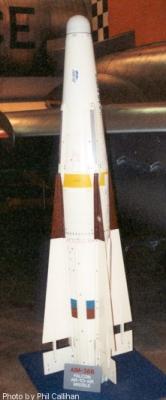Hughes GAR-11/AIM-26 Falcon
The AIM-26 Falcon was the only guided nuclear-armed air-to-air missile ever deployed by the USAF. Development of a nuclear-armed derivative of the AIM-4 Falcon family was first planned in 1956, when Hughes was contracted to develop the XGAR-5 and XGAR-6 missiles. These missiles were intended to be significantly larger than the standard Falcon (length/diameter increased from 2.0 m/0.16 m (80 in/6.4 in) to about 3.5 m/0.30 m (140 in/12 in)), and were to be used against high and fast-flying missiles and bombers. The two variants were identical, except for the guidance method - semi-active radar homing for the XGAR-5, and infrared homing for the XGAR-6. However, development was cancelled early in the design phase.
Development of a nuclear-armed Falcon derivative started again in 1959, when it was decided that USAF interceptors needed a head-on kill capability against enemy bombers. This dictated radar homing (IR seekers of the day could only home on hot exhaust), but this was considered too inaccurate for a conventionally armed missile. Therefore a low-yield W-54 nuclear warhead was planned for the missile, which was designated as GAR-11.
The GAR-11 was slightly larger, and significantly heavier than the original Falcon. Testing of the XGAR-11 proceded without problems during 1960, and in 1961, the GAR-11 became operational with F-102 interceptors. The nuclear warhead, and the inherent all-weather capability of the SARH guidance made the GAR-11 the most powerful air-to-air missile ever deployed. Detonation of the warhead was triggered by a radar proximity fuze.
However, the nuclear warhead also had a major disadvantage - the missile could not be used against low-flying aircraft over friendly territory. Therefore the conventionally armed GAR-11A was developed in parallel. The GAR-11A was relatively little used by the USAF, but was exported to Sweden (and license-built there) as RB-27.
 |
 | |
| Photo: Hughes | Photo: Phil Callihan | |
| GAR-11 (AIM-26A) | GAR-11A (AIM-26B) |
In 1963, the GAR-11 Falcon missiles were redesignated in the AIM-26 series. The XGAR-11, GAR-11, and GAR-11A became the XAIM-26A, AIM-26A, and AIM-26B, respectively.
Improvements in radar-homing in the late 1960's made the AIM-7 Sparrow missile effective in frontal attacks. This fact, together with the AIM-26A's unsuitability against low-level threats, led to a quick phase-out, and by 1971 the AIM-26A was no longer in service. The Swedish RB-27 (AIM-26B) was used by J 35 Draken fighters until the late 1990's. In total, about 4000 AIM-26 missiles of both variants were produced.
Specifications
Note: Data given by several sources show slight variations. Figures given below may therefore be inaccurate!
Data for GAR-11 (AIM-26A):
| Length | 2.14 m (84.2 in) |
| Wingspan | 0.620 m (24.4 in) |
| Diameter | 0.279 m (11 in) |
| Weight | 92 kg (203 lb) |
| Speed | Mach 2 |
| Range | 8-16 km (5-10 miles) |
| Propulsion | Thiokol M60 solid-fuel rocket; 26 kN (5800 lb) |
| Warhead | W-54 nuclear fission warhead (0.25 kT *) |
Main Sources
[1] James N. Gibson: "Nuclear Weapons of the United States", Schiffer Publishing Ltd, 1996
[2] Bill Gunston: "The Illustrated Encyclopedia of Rockets and Missiles", Salamander Books Ltd, 1979
Back to Current Designations Of U.S. Unmanned Military Aerospace Vehicles
Back to Directory of U.S. Military Rockets and Missiles
Last Updated: 9 May 2007